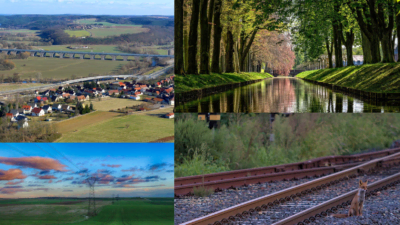Key points
- If business-as-usual prevails, by 2050, there will be twice as many roads and railways than in 2010..
- 27 % of the land surface in the EU- (27+UK) is highly fragmented
- Transport sustainability policies focus on CO2 reduction, but largely miss another key issue: tackling biodiversity loss
- The central focus of a sustainable transport policy must be on reducing transport demands.
- Solutions that jointly address climate change and biodiversity loss are essential to having a net positive impact on biodiversity as well as developing resilient, safe, and sustainable transport infrastructure systems
While Europe currently has an estimated 6 million kilometers of road and rail networks, this is predicted to expand substantially in the coming years, particularly in Eastern Europe which is seeking to expand and modernise its transport infrastructure. However, this region is the home of many rare and endangered species, and also contains productive landscapes and functional ecosystems due to a long history of extensive small-scale farming. Here, infrastructure and the entire transport system will have to be very carefully designed to preserve biodiversity and ecosystem services. On the other hand, the focus in Western Europe is on repairing and restoring biodiversity values. Europe needs to implement innovative and sustainable solutions to stop the decline of native species and the fragmentation of ecosystems for which transport infrastructure is partly responsible. Existing infrastructure must also be adapted to overcome flooding, droughts, and forest fires due to climate change. Mitigating the spread of invasive species, which between 1960 and 2020 cost 116.61 billion euros, is also a priority

|
The BISON reports provide information, analysis, and tools to prevent nature from being further impacted by transport infrastructure. They provide recommendations for restoring ecological functions already lost or damaged by traffic and infrastructure. The BISON reports explore some of the recognised trends and predicted changes in transport, technology, the climate, natural environment, and in human societies. The reports also examine the challenges and opportunities for mainstreaming biodiversity in the European transport infrastructure sector. |
The impact of the transport sector on biodiversity and mitigation needs. |
Where the transport sector (traffic and infrastructure) is responsible for biodiversity loss and where they need to be mitigated are as follows:
- The barrier effect and subsequent wildlife mortality rates . To avoid having this impact, natural processes and species movement need to be maintained across landscapes. Restoring ecological corridors and enhancing green and blue infrastructure that intersects transport infrastructure are good solutions.
- Pollution and disturbance in surrounding habitats. To protect the quality and integrity of the habitats, the spread of noise, light, chemicals, and waste, as well as invasive species, urgently need to be reduced.
- New roads often herald wide-reaching change. When transport infrastructure is built in natural pristine areas, people inevitably follow. Once the first blow has landed, the impact spreads leading to deforestation, forest fires, or habitat fragmentation
On the other hand,
- Transport infrastructure can provide new habitats hosting wildlife in road verges, stormwater basins, or airport green spaces, that can complement and enrich the surrounding landscape, and promote biodiversity and ecological functions.
A key focus for sustainable transport policies must be on reducing transport demands.
|
||||||||
|
||||||||
|

 This project has received funding from the European Union’s Horizon 2020 research and innovation programme under grant agreement
This project has received funding from the European Union’s Horizon 2020 research and innovation programme under grant agreement 